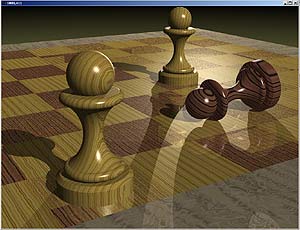The Persistence of Vision Ray Tracer (POV-Ray) is
an all round excellent package, but there are two things that particularly make
it stand out above the rest of the crowd. Firstly, it's free, and secondly, the
source is distributed so you can compile it on virtually any
platform.
Lower numbers denote faster calculation times
(seconds), and hence, better performance.

| POVRay Benchmark Results (lower is better) |
|
Processor |
seconds |
Ranking |
| 1. |
Pentium 4 2 GHz |
299 sec |
 |
| 2. |
AthlonXP 2000+ |
189 sec |
 |
| 3. |
AthlonXP 2100+ |
183 sec |
 |
| 4. |
AthlonXP 2100+ (oc'ed) |
171 sec |
 |
With no
special instructions for either CPU, the AthlonXP's
powerful FPU simply destroy's the Pentium 4 in POVray. Knowing AMD's history with
number crunching this is not very surprising to see.
SuperPI calculates the number PI to 1 Million
digits in this raw number crunching benchmark. The benchmark is fairly diverse
and allows the user to change the number of digits of PI that can be calculated
from 16 Thousand to 32 Million. The benchmark, which uses 19
iterations in the test, is set 1 Million digits.
Lower numbers denote faster calculation times
(seconds), and hence, better performance.
| Super PI (1 Million digits) Benchmark Results (Lower is better) |
|
Processor |
seconds |
Ranking |
| 1. |
Pentium 4 2 GHz |
95 sec |
 |
| 2. |
AthlonXP 2000+ |
75 sec |
 |
| 3. |
AthlonXP 2100+ |
66 sec |
 |
| 4. |
AthlonXP 2100+ (oc'ed) |
60 sec |
 |
Like
POVRay, SuperPI is a pure FPU benchmark and again the AthlonXP does very well
here.
3DMark2000 is still a popular benchmarks for
evaluating 3D performance even though it is getting a bit dated. 3DMark2000
continues to provide benchmark results that gage DirectX7 performance and
hardware transformation and lighting that older games still use. Version 1.1
ensures more reliable functionality with hardware and operating systems that
were released after the launch of 3DMark2000 in December 1999. Higher numbers
denote better performance.
| 3DMark 2000 v1.1 Benchmark
Results |
|
Processor |
3DMarks |
Ranking |
| 1. |
Pentium 4 2 GHz |
9221 |
 |
| 2. |
AthlonXP 2000+ |
11114 |
 |
| 3. |
AthlonXP 2100+ |
11816 |
 |
| 4. |
AthlonXP 2100+ (oc'ed) |
12440 |
 |
Using a
GeForce3 Ti500, 3DMark2000 becomes more of a CPU
benchmark then anything else, and here the AthlonXP stomps all over the P4. In 3DMark2000
the driver difference between the 21.83 and 22.80's should be less than
1%-3%.
